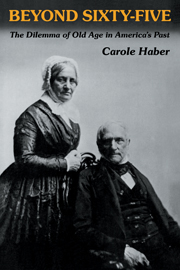Book contents
- Frontmatter
- Contents
- List of Tables
- Acknowledgments
- INTRODUCTION: Classifying Society's Superannuated
- CHAPTER ONE Aging in Colonial America
- CHAPTER TWO Social Realities and Perceptions of Old Age in the Nineteenth Century
- CHAPTER THREE Medical Models of Growing Old
- CHAPTER FOUR Treating the Postclimacteric Stage
- CHAPTER FIVE Institutionalizing the Elderly
- CHAPTER SIX The Pension Barrier
- CONCLUSION: Old Age in a Bureaucratic Society
- Notes
- A Note on Secondary Sources
- Index
CHAPTER SIX - The Pension Barrier
Published online by Cambridge University Press: 26 February 2010
- Frontmatter
- Contents
- List of Tables
- Acknowledgments
- INTRODUCTION: Classifying Society's Superannuated
- CHAPTER ONE Aging in Colonial America
- CHAPTER TWO Social Realities and Perceptions of Old Age in the Nineteenth Century
- CHAPTER THREE Medical Models of Growing Old
- CHAPTER FOUR Treating the Postclimacteric Stage
- CHAPTER FIVE Institutionalizing the Elderly
- CHAPTER SIX The Pension Barrier
- CONCLUSION: Old Age in a Bureaucratic Society
- Notes
- A Note on Secondary Sources
- Index
Summary
Not every old person, of course, spent his or her final days confined to an institution. Throughout the nineteenth century, only a small percentage of the elderly ever sought refuge in an almshouse, oldage home, or insane asylum. The great majority remained beyond the institution's walls, reliant upon their own resources and abilities or the support of relatives.
By the late nineteenth century, however, even the uninstitutionalized elderly began to be affected by the growing social differentiation of senescence. Mandatory retirement, as dictated by pension programs initiated during this period, began to place a distinctive barrier between old age and the rest of society. Adopted almost simultaneously by large industries, the military, and the civil service, pensions uniformly defined their elderly beneficiaries as diseased and dependent. No physical examination or means test would be required to prove the dire condition of their existence. According to the assumption written into these plans, the man or woman over sixty-five (or, at most, seventy) was beyond the age of usefulness. Regardless of actual physical state, this person had entered a stage distinctive for its weakness and dependence. In time, it would seem both natural and correct that such elderly persons should be denied access to employment. This attitude developed, as we shall see, out of events and ideas of the late nineteenth and early twentieth centuries. The pensions that produced and enforced mandatory retirement were a vivid response both to contemporary industrial conflict and to the growing awareness of the plight of the elderly.
- Type
- Chapter
- Information
- Beyond Sixty-FiveThe Dilemma of Old Age in America's Past, pp. 108 - 124Publisher: Cambridge University PressPrint publication year: 1983

